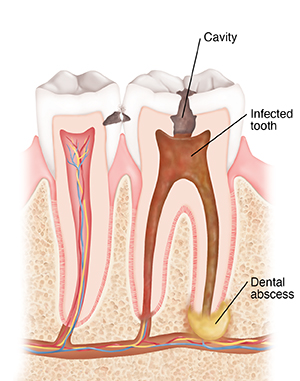Dental Abscess with Facial Cellulitis
A dental abscess is a pocket of fluid (pus) at the tip of a tooth root in your jawbone. It's caused by an infection. The infection often starts with a crack or cavity in a tooth. Symptoms may include mouth pain and swelling, fever, red gums, and bad taste in the mouth. The pain is often worse when having hot or cold food or drinks, or biting on hard foods. It may spread from the tooth to your ear, or to the area of your jaw on the same side.

If the infection isn’t treated, more serious infections may spread to the face (facial cellulitis). Facial cellulitis is an infection of the skin and the soft tissues beneath it. This is a very serious condition. It should be treated right away. Once the infection and swelling starts, it can spread quickly. Symptoms include red and swollen skin, fever, chills, and extreme tiredness (fatigue).
Home care
Follow these tips when caring for yourself at home:
-
Don't have hot and cold foods and drinks. Your tooth may be sensitive to changes in temperature. Don’t chew on the side of the infected tooth.
-
Put a cold pack on your jaw over the sore area. This can help reduce swelling and pain.
-
You may use over-the-counter medicine to ease pain, unless another medicine was prescribed. Talk with your health care provider first before using acetaminophen or ibuprofen if:
-
You have chronic liver or kidney disease.
-
You’ve had a stomach ulcer.
-
You've had GI (gastrointestinal) bleeding.
-
Your provider will prescribe an antibiotic. Take it exactly as directed. Finish all the medicine even if you feel better. This helps to make sure the infection completely clears.
Follow-up care
Follow up with your provider, dentist, or oral surgeon, as advised. Severe cases of cellulitis must be checked again in 24 hours. Once a tooth infection happens, it'll be a problem until the infection is drained. This is done through surgery or a root canal. Or you may need to have your tooth pulled.
Call 911
Call 911 if:
-
Swelling spreads to the upper half of your face or neck.
-
Your eyelids start to swell shut.
-
You have vision problems.
-
You have abnormal drowsiness or confusion.
-
You have a headache or a stiff neck.
-
You have weakness or fainting.
-
You have trouble swallowing or breathing.
When to contact your doctor
Contact your doctor or get medical care right away if:
-
The pain gets worse or spreads to your neck.
-
The swelling or redness gets worse.
-
You have a fever of 100.4°F (38°C) or higher, or as directed by your provider.
Online Medical Reviewer:
Daphne Pierce-Smith RN MSN
Online Medical Reviewer:
Rita Sather RN
Date Last Reviewed:
3/1/2025
© 2000-2025 The StayWell Company, LLC. All rights reserved. This information is not intended as a substitute for professional medical care. Always follow your healthcare professional's instructions.